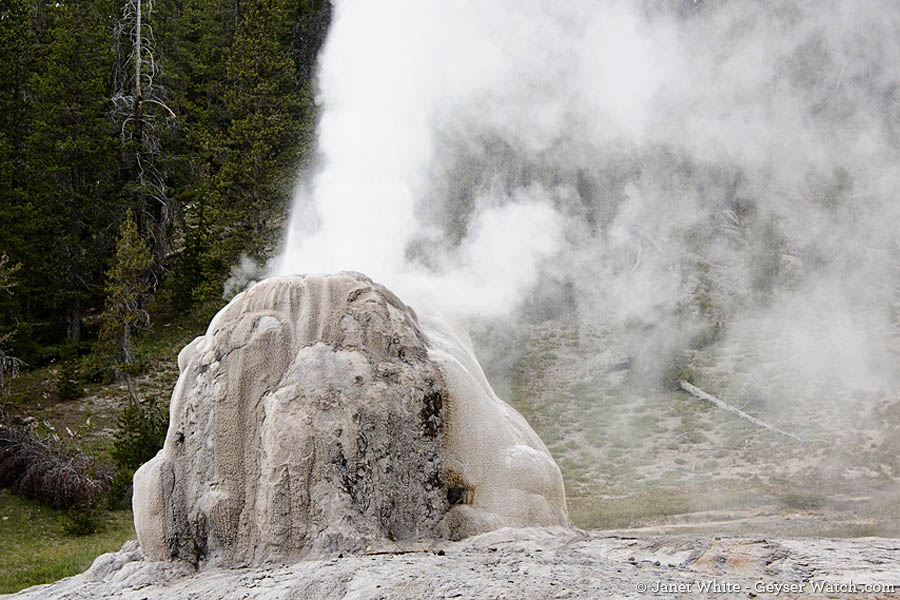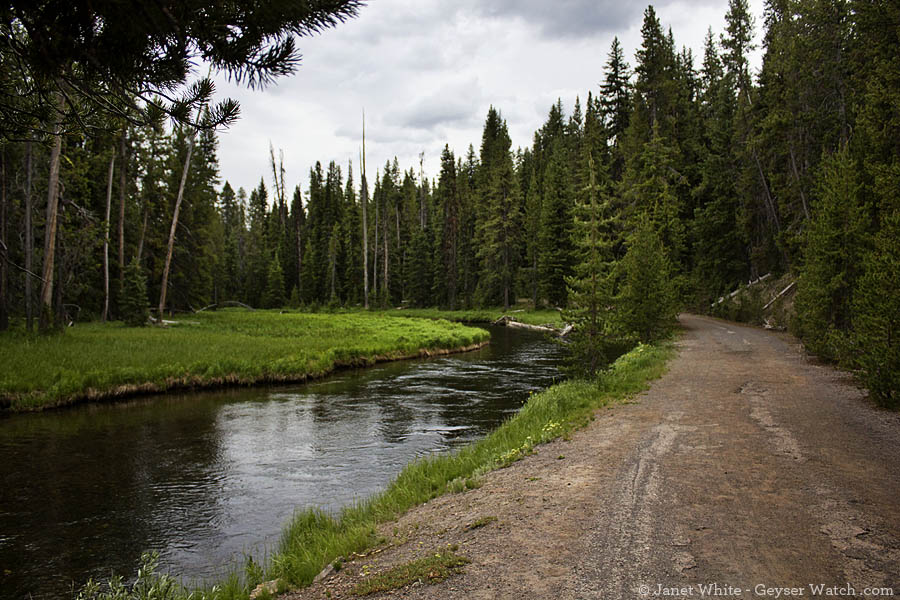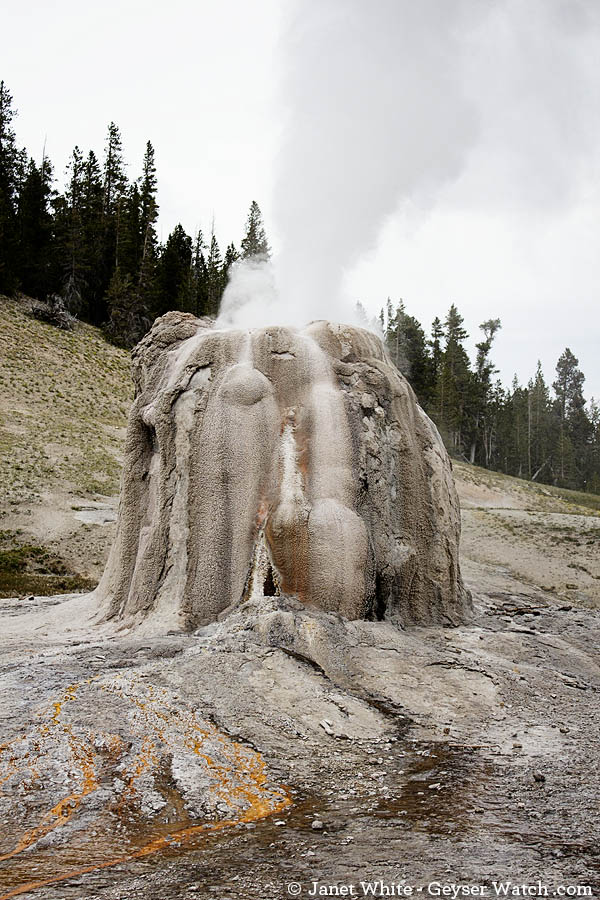
Lone Star geyser erupts from a 10-foot cone of minerals built up over many years. (GeyserWatch.com/Janet White - click to enlarge)
Parked for a Day is a user-submitted feature that lets readers share favorite activities in Yellowstone and Grand Teton national parks. Parked for a Day activities require parking the car, and can be done in a single day. Share your favorite Parked for a Day activity and we’ll feature it on Yellowstone Gate.
By Janet White
A day trip to Lone Star Geyser in Yellowstone National Park is a short and pleasant day hike or a fun bike ride, and a great way to spend some time off the beaten path. The path to Lone Star Geyser follows the Firehole River for the five-mile round trip, passing through green meadows and wildflowers that line the trail, an old road now closed to vehicles.
Lone Star Geyser erupts about every three hours, with a few smaller, minor eruptions occurring before the major eruption. The major burst can last for up to 3o minutes, and ends in a strong steam phase. When you arrive at the geyser, check the log book to see if anyone recorded any recent eruptions so you’ll know when it’s likely to blow again, and feel free to enter details about what you see to help other visitors.
If you want to be sure to see Lone Star Geyser erupt, plan a half-day trip to give yourself time to wait and linger this peaceful setting. Keep your eyes open for wildlife as well.
Access the Lone Star Geyser trailhead just past the Kepler Cascades parking lot on the Grand Loop Road, less than 2 miles east of Old Faithful, or just over 15 miles west of West Thumb.

The old vehicle road that serves as the Lone Star Geyser trail follows the Firehole River. (Janet White / GeyserWatch.com - click to enlarge)
On a recent trip from Cody, my husband, Mike, and I decided to check out Lone Star Geyser as an easy way to try out a pair of newly purchased bikes, because the trail is fairly level and a favorite biking route. It’s an old road that autos used for years to reach Lone Star Geyser, but it was closed to visitor traffic in 1972. (In the winter, cross-country skiers coming from Old Faithful frequently use the trail.)
In a short distance, the traffic noise from the main road fades, and the silence wraps around us like a comforter. The old road follows the clear water of the Firehole River and winds through tall lodgepole pines, with a few Engleman spruce and Douglas fir trees sprinkled in. Beneath them, the lush green grass grows alongside columbines, lupines and other wildflowers. The waters call to my husband to fish there, so I imagine we’ll return soon to let him match his fly-fishing skills against the brook trout.
We pass by an open meadow that looks like it should have a moose, elk or bear standing in it. This trail is closed early in the season because of the bears that frequent the area. They may still show up at any time, but today we don’t see any. We still have bear spray ready, though, just in case.
We haven’t been to Lone Star before, so we’re not familiar with the trail, and wonder how many small hills and gentle turns it takes to reach it. Around this bend? The next? In a short time, we arrive to feel small drops of water hitting us, and the sound of an eruption tells us Lone Star is already going.

Lone Star Geyser erupts about every three hours. (Janet White/ GeyserWatch.com - click to enlarge)
It looks like a major eruption, but we are unable to really see it clearly, as we’re on the downwind side, receiving the “geyser blessing.” If I’m not careful to dry off this “geyser kiss” promptly, it will leave a trace of the same silica on my camera lens that has built the 10-foot cone at the base of the geyser.
I tuck my camera under my jacket, look at Mike, and we decide to run through the spray to gain a better vantage point. As we run, I take off my glasses to protect them as well.
On the other side, we see the water jetting high into the air. But after talking with an visitor who arrived earlier, we learn it was a bit taller at the start — just a few minutes before we arrived. A few minor eruptions had preceded this one, but this was definitely the big one in the cycle, with water reaching about 40 feet high and now starting to shift to steam.
We stayed through the the loud, long steam phase. As it died away, the small group of about a dozen spectators applauded, and Lone Star responded with a few extra puffs of steam.
The ride back to the parking lot was easy and relatively quick. Some much-needed rain started to fall as the car came into sight. Perfect timing. Lone Star was the first geyser to greet us on this trip, and parking the car and getting out there was well worth it.
Janet White is a photographer and geyser enthusiast who created GeyserWatch.com.

I love the quote, “In a short distance, the traffic noise from the main road fades, and the silence wraps around us like a comforter.” Excellent writing, Janet! And so true!
Thanks, Christopher. :)
Hi Janet!
I really enjoyed your piece on the Lone Star Geyser trail. In fact, I liked it so much that my husband and I finally hiked to Lone Star this past weekend. I don’t know why we never visited before, but thanks to your article we finally got there. It was just as you described-well worth the walk. Thanks again for your wonderful article!
So glad this inspired you – it’s definitely a spot I plan to visit again myself. :)